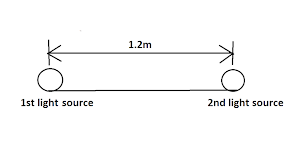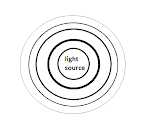
Two light sources with equal luminous intensity are lying at a distance of 1.2 m from each other. Where should a screen be placed between them such that illuminance on one of its faces is four times that on another face?
A. \[0.2{\text{ }}m\]
B. \[0.4{\text{ }}m\]
C. \[0.8{\text{ }}m\]
D. \[1.6{\text{ }}m\]
Answer
147.9k+ views
Hint: First think how light propagates through any surface. Then find out the relation between intensity of light with distance. Now you can draw the picture to make the question easier. At last, assume a distance x m form source and solve the equations.
Formula used:
The expression of intensity of wave is,
$I = \dfrac{{{\text{amount of light }}}}{{{\text{area }}}}$
\[{E_2} = 4{E_1}.{\text{ }}If{\text{ }}x{\text{ is distance from 1st source}},\]
Here ${E_1} = {\text{ intensity of light of 1st source}}$ and ${E_2} = {\text{ intensity of light of 2nd source}}$
Complete step by step solution:
First make a diagram for proper visualization

light intensity and distance are inversely proportional with each other. as the distance increases, the light intensity decreases. if the light source moves farther away, the light spreads over to more area. So light decreases in specific proportion with distance of light. Up to this all we say is general observation. Now let’s check this out scientifically. how light propagates through a medium. Let’s see it with a picture.

So now we can easily observe how light is really propagated. But it is a 2D view in 3D it obviously looks like a sphere. Now come to the point : what is the intensity of light? Intensity of light means the amount of light (lumens) falling on a surface over any given $foo{t^2}$or ${m^2}$. That says light intensity can be written in terms of lumens per square foot (foot candles) or lumens per square meter (lux).
If we formulize it then we get
$I = \dfrac{{{\text{amount of light }}}}{{{\text{area }}}}$
$\Rightarrow I= \dfrac{{{\text{amount of light}}}}{{4\pi {r^2}}}$
$\Rightarrow I= \dfrac{{{\text{amount of light}}}}{{\dfrac{4}{3} \times \pi {r^2}}}$
In both the cases we can clearly see that light is proportional to the inverse of ${r^2}$ which means the square of distance. I think Up to now it's all clear. So, we can say that $I\varpropto\dfrac{1}{{{r^2}}}$.
In the given question we have to find a place between them such that the illuminance on one of its faces is four times that on another face. Let’s solve it. Let’s take the required distance at a $x{\text{ m}}$ from the first object. So, now we can compare at this point due to two sources.
\[{E_2} = 4{E_1}.{\text{ }}If{\text{ }}x{\text{ is distance from 1st source}},\]
Here ${E_1} = {\text{ intensity of light of 1st source}}$ and ${E_2} = {\text{ intensity of light of 2nd source}}$.
\[\dfrac{I}{{{{(1.2 - x)}^2}}} = \dfrac{I}{{4{x^2}}}\]
\[\Rightarrow \dfrac{1}{{1.2 - x}} = \dfrac{2}{x}\]
\[\Rightarrow 3x = 2.4\]
\[\therefore x = 0.8\,m\]
Hence our answer is $0.8\,m$.
Therefore, option C is the correct answer.
Note: As the distance increases, the light intensity decreases. If the light source moves farther away, the light spreads over to more areas. Light is proportional to the inverse of ${r^2}$ which means the square of distance.
Formula used:
The expression of intensity of wave is,
$I = \dfrac{{{\text{amount of light }}}}{{{\text{area }}}}$
\[{E_2} = 4{E_1}.{\text{ }}If{\text{ }}x{\text{ is distance from 1st source}},\]
Here ${E_1} = {\text{ intensity of light of 1st source}}$ and ${E_2} = {\text{ intensity of light of 2nd source}}$
Complete step by step solution:
First make a diagram for proper visualization

light intensity and distance are inversely proportional with each other. as the distance increases, the light intensity decreases. if the light source moves farther away, the light spreads over to more area. So light decreases in specific proportion with distance of light. Up to this all we say is general observation. Now let’s check this out scientifically. how light propagates through a medium. Let’s see it with a picture.

So now we can easily observe how light is really propagated. But it is a 2D view in 3D it obviously looks like a sphere. Now come to the point : what is the intensity of light? Intensity of light means the amount of light (lumens) falling on a surface over any given $foo{t^2}$or ${m^2}$. That says light intensity can be written in terms of lumens per square foot (foot candles) or lumens per square meter (lux).
If we formulize it then we get
$I = \dfrac{{{\text{amount of light }}}}{{{\text{area }}}}$
$\Rightarrow I= \dfrac{{{\text{amount of light}}}}{{4\pi {r^2}}}$
$\Rightarrow I= \dfrac{{{\text{amount of light}}}}{{\dfrac{4}{3} \times \pi {r^2}}}$
In both the cases we can clearly see that light is proportional to the inverse of ${r^2}$ which means the square of distance. I think Up to now it's all clear. So, we can say that $I\varpropto\dfrac{1}{{{r^2}}}$.
In the given question we have to find a place between them such that the illuminance on one of its faces is four times that on another face. Let’s solve it. Let’s take the required distance at a $x{\text{ m}}$ from the first object. So, now we can compare at this point due to two sources.
\[{E_2} = 4{E_1}.{\text{ }}If{\text{ }}x{\text{ is distance from 1st source}},\]
Here ${E_1} = {\text{ intensity of light of 1st source}}$ and ${E_2} = {\text{ intensity of light of 2nd source}}$.
\[\dfrac{I}{{{{(1.2 - x)}^2}}} = \dfrac{I}{{4{x^2}}}\]
\[\Rightarrow \dfrac{1}{{1.2 - x}} = \dfrac{2}{x}\]
\[\Rightarrow 3x = 2.4\]
\[\therefore x = 0.8\,m\]
Hence our answer is $0.8\,m$.
Therefore, option C is the correct answer.
Note: As the distance increases, the light intensity decreases. If the light source moves farther away, the light spreads over to more areas. Light is proportional to the inverse of ${r^2}$ which means the square of distance.
Recently Updated Pages
JEE Main 2023 (January 29th Shift 1) Physics Question Paper with Answer Key

JEE Main 2021 July 20 Shift 2 Question Paper with Answer Key

JEE Main 2023 January 30 Shift 2 Question Paper with Answer Key

JEE Main 2022 (June 24th Shift 1) Physics Question Paper with Answer Key

Equivalent Capacitance - Important Concepts and Tips for JEE

JEE Main 2023 (April 6th Shift 1) Physics Question Paper with Answer Key

Trending doubts
JEE Main 2025 Session 2: Application Form (Out), Exam Dates (Released), Eligibility, & More

JEE Main Exam Marking Scheme: Detailed Breakdown of Marks and Negative Marking

JEE Main 2025: Derivation of Equation of Trajectory in Physics

Electric Field Due to Uniformly Charged Ring for JEE Main 2025 - Formula and Derivation

JEE Main Participating Colleges 2024 - A Complete List of Top Colleges

Degree of Dissociation and Its Formula With Solved Example for JEE

Other Pages
JEE Advanced Marks vs Ranks 2025: Understanding Category-wise Qualifying Marks and Previous Year Cut-offs

JEE Advanced 2025: Dates, Registration, Syllabus, Eligibility Criteria and More

JEE Advanced Weightage 2025 Chapter-Wise for Physics, Maths and Chemistry

Electric field due to uniformly charged sphere class 12 physics JEE_Main

Learn About Angle Of Deviation In Prism: JEE Main Physics 2025

Electrical Field of Charged Spherical Shell - JEE




